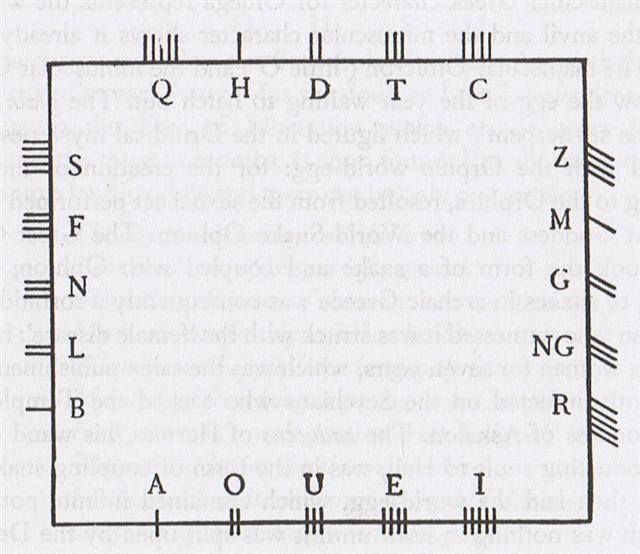|
Ogham texts were written from bottom up and from left to right, i.e.
in a way reminiscent of how rongorongo was written.
"The more ancient examples are standing stones, where the script was carved into the edge (droim or faobhar) of the stone, which formed the stemline against which individual characters are cut. The text of these 'Orthodox Ogham' inscriptions is read beginning from the bottom left-hand side of a stone, continuing upward along the edge, across the top and down the right-hand side (in the case of long inscriptions)." (Wikipedia) Each sign consisted of a number of short straight lines, like tally-marks, and these marks were carved across or at the edges. Two versions will exemplify:
The irregular marks for Z and Q (or Q and Z) correspond to the position of the thrush (SS) respectively to CC (cfr the picture on the preceding page). I guess Q in the top version is not a letter which has dropped down from the 'lintel' but instead reflects S (the hawk) in keeping the lintel horizontal. In between the Sun King will be hidden among the branches of the 'Tree'. Z is 'falling on his face' in the top version and in the bottom version Q has the central vertical line cut short. Both signs apparently indicate the fate of Spring Sun. Both versions also had 11 ('one more') as the sum of M, G, NG, and R, which agrees with how the next year cycle began with high summer. The 4 original 'lintel' letters measure out 10. The pictures are from The White Goddess and the peculiar additions of Z and Q (or SS and CC) are explained thus by Graves: "There is a reference in Amergin's song to the 'secrets of the unhewn dolmen'. It will be seen that there is room for an extra letter at each corner of the dolmen arch which I constructed to elucidate the reference to Oghams being nicked on the edges, not painted on the face, of the stones. It will be observed that the seventh to eleventh letters of this alphabet, which follow the same sequence in the Boibel-Loth, are the letters H.D.T.C.Q. These letters, as Sir John Rhys has pointed out, form the initials of the Old Goidelic numerals, from one to five: a hoina, a duou, a teri, a ccetuour, a qquenque, which correspond very nearly to the Latin numerals unum, duo, tres, quattuor, quinque. This may explain why the inventors of the Boibel-Loth made H.D.T.C.Q. the central five letters of the alphabet and transferred Z to a position between NG and R. Yet the ancientness of the Old Goidelic numerals suggests that in the original Beth-Luis-Nion finger alphabet the first flight of consonants - the Spring months - numbered only five, not six, to allow H.D.T.C.Q. to form the second or Summer series, and that Z was therefore reckoned to the last series, the Winter series ..." Possibly H.D.T.C.Q. had T as the central midsummer letter, in agreement with the form of the oak after it had been lopped to the shape of T: ... At mid-summer, at the end of a half-year reign, Hercules is made drunk with mead and led into the middle of a circle of twelve stones arranged around an oak, in front of which stands an altar-stone; the oak has been lopped until it is T-shaped ... And T would have been consonant number 8. ... The joints are roasted at twin fires of oak-loppings, kindled with sacred fire preserved from a lightning-blasted oak or made by twirling an alder- or cornel-wood fire-drill in an oak log. The trunk is then uprooted and split into faggots which are added to the flames. The twelve merry-men rush in a wild figure-of-eight dance around the fires ... |

